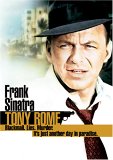| Reviews & Columns |
|
Reviews DVD TV on DVD Blu-ray 4K UHD International DVDs In Theaters Reviews by Studio Video Games Features Collector Series DVDs Easter Egg Database Interviews DVD Talk Radio Feature Articles Columns Anime Talk DVD Savant Horror DVDs The M.O.D. Squad Art House HD Talk Silent DVD
|
DVD Talk Forum |
|
|
| Resources |
|
DVD Price Search Customer Service #'s RCE Info Links |
|
Columns
|
|
|
Tony Rome
The film's set-up is reminiscent of The Big Sleep. The former Miami Beach cop turned private dick is hired by wealthy construction company president Rudy Kosterman (Simon Oakland) to keep an eye on his troubled daughter, Diana (Sue Lyon), who disappeared from home only to turn up later dead drunk at a sleazy motel. Though unharmed, everyone seems very concerned about a missing diamond pin worth $5,000, peanuts to this family, and which turns out to be but the tip of the iceberg in a larger plot to get at Kosterman's millions.
Suspects include Tony's ex-partner, Turpin (Robert J. Wilkie); Kosterman's wife, Rita (Gena Rowlands), a former cocktail waitress with a shady past; and Diana's mother and Rudy's first wife, Lorna (Jeanne Cooper), now a pathetic alcoholic living with her second husband (Jeffrey Lynn).
Tony Rome takes the convoluted plotting, eccentric characters, and hard-boiled dialogue of '40s private eye movies, transporting it lock, stock, and barrel to sunny Miami Beach, a glamorous getaway whose peerless seashore and exciting nightlife are marred by a seedy underworld of hookers and junkies. Most of the picture seems to have been shot there, and director Gordon Douglas and DP Joseph F. Biroc make good use of the Fontainebleau Hotel and other local hotspots. Though visually the antithesis of '40s noir, the juxtaposition of older and contemporary elements works surprisingly well. Though the picture opens in typical Sinatra movie style - daughter Nancy belts out the silly title song ("Tony Rome'll getcha if you don't watch out!"), and Frank is seen on his bachelor pad boat wearing a yellow turtleneck and captain's cap, ogling a woman's ass - once it gets down to business the over-the-top shenanigans of Sinatra's chairman of the board persona mostly vanishes.
Sinatra's real-life background, his streetwise roots and concurrent ties to organized crime give his film an authenticity it might otherwise not have. He really seems to know this underworld milieu quite well, and the use of good, hard-edged actors like Richard Conte, Simon Oakland, and Robert Wilke helps a lot. Shecky Greene, of all people, has a substantial role as a hitman and is almost shockingly good, in a relaxed performance worthy of James Gandolfini.
The gritty realism is seriously undermined by laughable dialogue that tries too hard to be hip, racy, and topical. "Somebody'll squeeze something out of Tony the day Georgia elects a colored governor," says one cop. There are numerous references to junkies and "H," thinly-coded lesbians, hookers, and strippers. "I got needle fever, that's for sure!" is typical. The film might have seemed very adult to some in 1967, but even by 1969 standards movies like this were fast becoming a joke in the wake of more serious and daring fare (Midnight Cowboy, etc.). It comes as no surprise that Richard L. Breen adapted Marvin H. Albert's novel; Breen set the template for the Joe Friday vs. the hippies Dragnet series, though he died soon after it premiered and was long gone by the time Tony Rome hit theaters in November 1967.
One good idea was pairing Sinatra with salty, sexy Jill St. John, whose racy Ann Archer is as hard-boiled and hard-drinking as he is (he's gin, she's vodka). Though young enough to be his daughter (indeed, the actress is just two months younger than Frank's daughter Nancy), St. John is on equal footing, neither intimidated nor overly captivated by ol' Blue Eyes' charm.
Video & Audio
Filmed in Panavision (Fox having dumped its Bausch & Lomb CinemaScope lenses earlier that same year), Tony Rome is presented in a good transfer preserving its original aspect ratio and is 16:9 anamorphic. The image is clean with good color for its age and given original lab's De Luxe's generally unimpressive color during this period. Audio includes English tracks in both the original mono and in a new stereo mix, which seems to enhance Billy May's score and Nancy Sinatra's title song alone.
Extra Features
The only extra is a batch of trailers, including Tony Rome's sequel, Lady in Cement (1968) and that same year's The Detective. The trailer for Tony Rome is 16:9 enhanced in 1.85:1 format, complete with text and narration. Also included are trailers for a gaggle of Raquel Welch titles, Sinatra's co-star in Lady in Cement: Bandolero!, Fantastic Voyage, Fathom, Mother, Jugs, and Speed, and One Million Years, B.C..
Parting Thoughts
Though no one would ever confuse Tony Rome with The Big Sleep or Murder, My Sweet, in some respects it's a better movie than it ought to be. It doesn't exactly overflow with innovation, but it's harmless and diverting.
Stuart Galbraith IV is a Los Angeles and Kyoto-based film historian whose work includes The Emperor and the Wolf -- The Lives and Films of Akira Kurosawa and Toshiro Mifune. His new book, Cinema Nippon will be published by Taschen in 2005.
|
| Popular Reviews |
| Sponsored Links |
|
|
| Sponsored Links |
|
|
| Release List | Reviews | Shop | Newsletter | Forum | DVD Giveaways | Blu-Ray | Advertise |
|
Copyright 2024 DVDTalk.com All Rights Reserved. Legal Info, Privacy Policy, Terms of Use,
Manage Preferences,
Your Privacy Choices | |||||||













